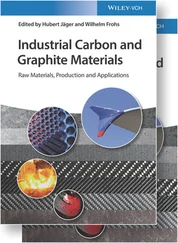1.1.4 Synthesis of Carbon Fibers
The process of synthesis of carbon fibers is patented and each company has its own trade secret. It is difficult to provide a detailed and very accurate process. It is therefore only possible to discuss an overall process without providing the intricacies of the actual process. Hence, the synthesis process of the most popular carbon fibers prepared from polyacrylonitrile (PAN) precursor is discussed here.
1.1.4.1 Carbon Fibers from PAN
Before carbon fibers are made from PAN, some pretreatments are made, like mixing Acrylonitrile powder with a suitable plastic (e.g., methyl acrylate, methyl methacrylate) and a catalyst to form a polyacrylonitrile plastic. This plastic is then spun to form the internal atomic structure of the fiber. These fibers are stabilized by heating them in air at about 200–300 °C for about 30–120 minutes. During this process some oxidation of carbon takes place, which helps to rearrange their atomic bonding pattern. These fibers are then carbonized at temperature 1000–3000 °C for several minutes in gas like argon (but in absence of any oxygen). By this process most of the non-carbon atoms and a few carbon atoms as well are lost in the form of gas like CO 2, CO, N 2NH 3, water vapor H 2, etc. This process helps to form strongly bonded carbon atoms that are aligned parallel to the long axis of the fiber. Due to losing different types of material during the carbonizing process, the surface of the fiber is very rough. Hence, to obtain better bonding properties, surfaces are oxidized in a controlled manner by techniques like exposing them in oxygen environments or by performing some chemical treatments like dipping them into some oxidizing solutions like nitric acid. In order to protect the fibers from environmental oxidation, they are coated with epoxy, polyester, nylon, urethane, and others.
1.1.5 Properties of Carbon Fibers
It is difficult to give the properties of carbon fibers by quantity because that depends on how the fiber was made and what treatments were done to the fiber. Here we give properties qualitatively only. Specific strength of carbon fiber (which is the ratio of strength to weight) is very high. Strength of material is the ratio of the force per unit area applied to fiber at which it breaks to its density. Carbon fiber is very rigid, i.e., its Young’s modulus is high. In other words, it needs high force to deflect it. The fiber is chemically stable and resistant to corrosion. Carbon fiber is electrically conductive and is resistant to fatigue, especially its composites. Carbon fiber has good tensile strength, which means it can stand maximum stress while it is stretched or pulled. Carbon fibers are normally fire resistant/nonflammable in the absence of oxygen. They are a good thermal conductor. Carbon fibers have a unique property of low coefficient of thermal expansion. They are nonpoisonous, biologically inert and X-ray permeable. These properties are especially good for any medical applications.
Some general properties of PAN-based fiber are given below, but these values may be different if PAN-based fibers are prepared under some specific condition. Hence, these data can be taken as approximate values.
Density: 1750–1870 kg/m3
Tensile strength: 0.9–6.37 kN/mm2
Young’s modulus: 40–588 kN/mm2
Elongation: 0.7%–2.2%
Filament diameter: 4.4–7.2 μm
Tensile strength of carbon fiber: 4127 MPa
Carbon fiber reinforced epoxy (thermal conductivity): 24 W/(m.K)
1.2 Properties of Carbon Nanofiber and How It Differs from Carbon Nanotube
Intrinsically, there is not much difference between carbon nanofiber and carbon nanotube. When a single layer of graphene sheet is rolled into a cylinder ( Figure 1.5a) it takes the shape of a single-walled carbon nanotube. When a multiple number of graphene sheets separated by a distance of 0.335 nm are rolled into a cylindrical shape it takes the shape of multi-walled carbon nanotubes ( Figure 1.5b). However, when broken sheets of multiple graphene sheets are rolled into a cylinder it takes the shape of carbon nanofiber ( Figure 1.5c). In other words, carbon nanofibers appear as cylindrical nanostructures with graphene layers organized as packed cones, cups or plates. The surface area of CNF is much larger compared to MWCNT of the same dimension, because the former has many broken graphene sheets which are not aligned as that of MWCNT (well-defined layer, as shown in the TEM image in Figure 1.5b).
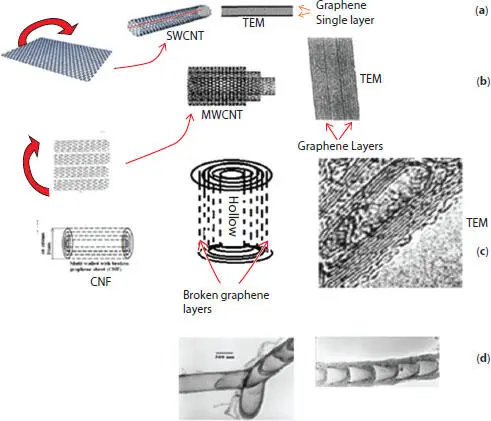
Figure 1.5 Schematic illustration of (a) how single layer of graphene folds to make a single-wall carbon nanotube; (b) how multilayers of graphene fold together to form a multi-walled carbon nanotube; and (c) sketch of how broken graphene layers fold to form a carbon nanofiber, and TEM image of CNF with broken graphene layers, and (d) TEM image of packed cones, cups.
Carbon nanofibers (CNFs) were first reported by Hughes and Chambers in a patent in 1889 [5] while carrying out the synthesis of filamentous carbon. Pyrolysis of methane/hydrogen gaseous mixture yielded carbon nanofibers in the form of a filament growth. The first electron microscopy observations of hollow carbon nanofibers of 50 nm in diameter was reported in the early 1950s by the Soviet scientists Radushkevich and Lukyanovich. Then, in 1988 Morinobu Endo [6] at Shinshu University, Japan, reported carbon nanofibers with a diameter of 1 μm and length of above 1 mm. In 1991, Yoshinori Ando [7] synthesized carbon nanomaterial by Arc process which was examined by Sumio Iijima while working at NEC as a new form of carbon nanotube. Pradhan synthesized carbon nanofibers by the pyrolysis of precursor camphor. Some of the peculiar shaped carbon nanofibers synthesized are shown in Figure 1.6.
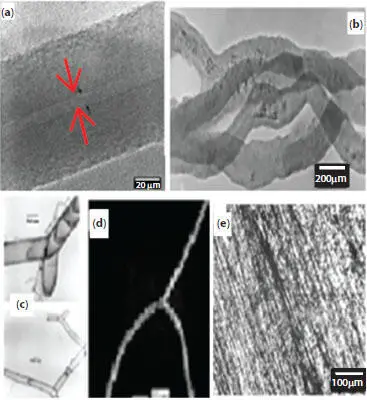
Figure 1.6 (a) TEM image showing graphene layers of (b) entwined carbon nanofibers synthesized at 1100 °C in presence of Ni: Al catalyst and n-hexane; (c, d) TEM images of open-ended bent, V-shaped inner novel growth of carbon nanotubes at 1000 °C in presence of nickel particles; and (e) SEM micrograph image of straight VGCFs (Source: Debabrata Pradhan, 2003) [4].
1.2.2 Role of Surface States in Controlling the Properties of CNFs
Carbon nanofibers possess excellent mechanical properties, high electrical conductivity, electromagnetic shielding and high thermal conductivity. Carbon nanofibers have average diameters ranging from 125–150 nm depending upon the precursors and technique used to manufacture them and have lengths ranging from 50–100 μm. They can form composites with various types of polymers and can be easily functionalized due to the presence of unique surface states ( Figure 1.7).
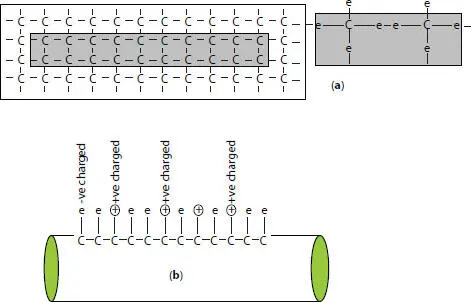
Figure 1.7 Schematic illustration showing (a) the formation of bonds of carbon atoms present at different layers of carbon fiber’s surface and missing of electrons from the top layer of carbon atoms; and (b) the effect of the missing electrons from the surface of top layer atoms, creating positive and negative charges which are responsible for making the carbon fibers reactive.
Читать дальше
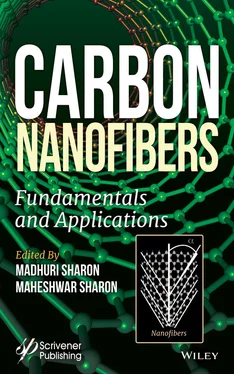




![Carbon - Посох с проблемами [калибрятина, куски]](/books/397599/carbon-posoh-s-problemami-kalibryatina-kuski-thumb.webp)

![Carbon - Ключ от магии, или Нимфа по вызову [СИ]](/books/417919/carbon-klyuch-ot-magii-ili-nimfa-po-vyzovu-si-thumb.webp)
![Carbon - Девушка с Косой [СИ]](/books/427728/carbon-devushka-s-kosoj-si-thumb.webp)




